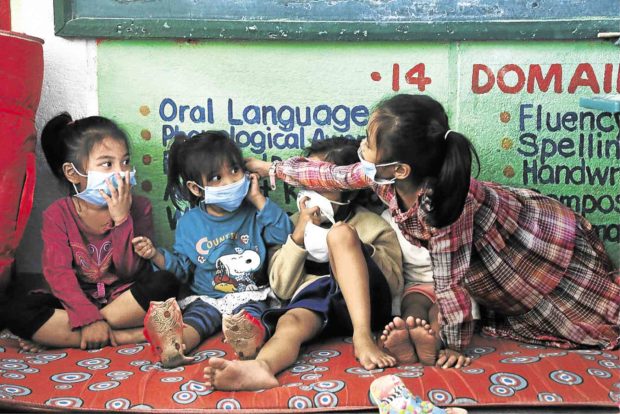13,100 Mayon evacuees sent home

These children cannot go home yet as they live inside a permanent danger zone around Mayon. —MARC ALVIC ESPLANA
LEGAZPI CITY—At least 13,100 evacuees had been sent home as authorities started clearing evacuation centers that had sheltered residents fleeing Mt. Mayon’s unrest in the cities of Legazpi and Ligao in Albay province.
The residents allowed to return homes, however, were only those living in areas outside a seven-kilometer radius considered safe by volcanologists.
Sleepless nights
Miladee Azur, head of the Legazpi City Disaster Risk Reduction and Management Council, cited a statement made by Renato Solidum Jr., Philippine Institute of Volcanology and Seismology (Phivolcs) director, that under Alert Level 3 only residents of areas inside a 6-to-7-kilometer radius were actually in harm’s way.
“There’s actually no reason for them to evacuate but they were fearful when they saw (Mayon’s rumbling),” said Azur of the more than 13,100 residents who fled their homes outside the 7-kilometer radius.
Article continues after this advertisement“That was voluntary evacuation. It was not a mandatory evacuation. We just accommodated their request to evacuate because they couldn’t sleep at night,” she added.
Article continues after this advertisementMariton Bornas, chief of the Volcano Monitoring and Eruption Prediction Division of Phivolcs Bicol, said allowing residents to return to their homes outside the 7-kilometer radius was acceptable.
She said, however, that an eruption was still imminent even if there were no changes detected in the volcano’s behavior since Alert Level 3 was raised on Jan. 14.
“Some media reports say that an explosive eruption is already impossible,” said Bornas. “That’s not true,” she said.
Lessons from Mayon
Previous eruptions, she said, showed that communities within reach of lava flow or ash explosions must not be complacent.
“If we look into the history of Mayon volcano eruptions—1968, 1984 and 2000—there had been lulls before an explosive eruption,” Bornas said.
Cordon
She said what people were witnessing now in Mayon “is the first scenario” of an eruption. The volcano would continue releasing lava, she added. “This is like a nonexplosive eruption.”
This kind of volcanic activity, Bornas said, could last up to a month.
Police had cordoned off the 6-kilometer permanent danger zone (PDZ) to prevent residents and tourists from straying into areas considered high risk during an eruption.
Supt. Dixon Berango, deputy operations officer of Albay police, said many evacuees from areas inside the PDZ kept trying to sneak past the cordon to get food or feed farm animals.
Maj. Gen. Jesus Manangquil Jr., the Army’s 9th Infantry Division commander, said Task Group Mayon, a quick response unit, had already been activated.